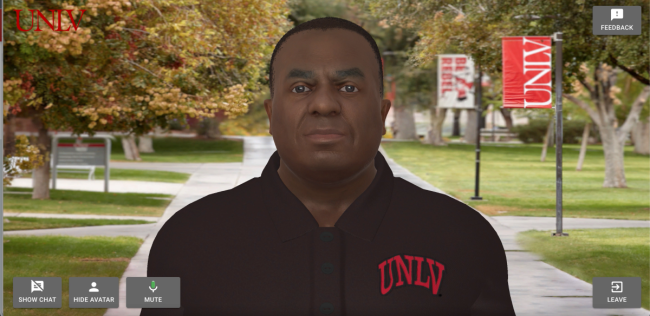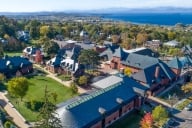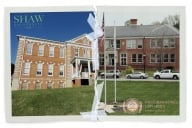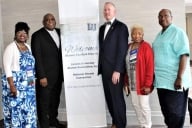You have /5 articles left.
Sign up for a free account or log in.

The digital avatar for Keith Whitfield, president of the University of Nevada at Las Vegas, can answer students’ questions with the help of artificial intelligence.
University of Nevada at Las Vegas
Keith Whitfield, president of the University of Nevada at Las Vegas, is available to chat with all 31,000 students at any hour of the day or night—as long as they don’t mind talking to a digital version of him.
The public research university recently unveiled the digital President Whitfield, an artificial intelligence and online avatar that can answer more than 1,000 questions about hundreds of university-related topics. Whitfield and the developers at AI Media Lab, the Nevada-based company that built the AI and avatar, hope the digital president will serve as a resource for students, employees and potential applicants.
Whitfield, who became president of UNLV in August 2020, was inspired to build an online version of himself after he toured Black Fire Innovation, a part of the technology park on campus that is dedicated to gaming and hospitality research. There, he met with two UNLV alumni who design artificial intelligence and avatars that mimic real people or mascots. Whitfield was so taken with the idea that he asked if they could build one for him.
“I really wanted to have a chance to speak to all students. My staff, very wisely, said, ‘You’re a little crazy. You can’t do 31,000 students—let’s be realistic,’” Whitfield said. “I said, ‘There’s got to be a way.’”
And so Russ Logan and his team got started. Logan is the co-founder and managing partner of AI Media Lab and has worked with brands and public agencies to design AIs just like Whitfield’s.
Developing the digital president took about seven months. Whitfield spent eight hours in a recording booth reading information about UNLV compiled by departments across the university. He also recited questions for the AI to ask students, as well as stories from his own life. All these recordings were later fed to the AI to inform its base of knowledge.
There’s a big difference between reciting information and recording conversations, Logan said. The AI also goes through testing with students, employees and others to fine-tune its dialogue.
“The content is just the content. The ability to take that content and make it natural and a conversation is a whole process in and of itself,” Logan said. “We have a dialogue system that we use and a person that’s in charge of dialogue to create the interactions that make it feel very, very natural, so that somebody wants to continue to engage and feels like it’s a normal conversation.”
The digital president can now address about 1,000 questions and can direct students to mental health resources, discuss financial aid assistance and reveal his favorite part of campus. Because it debuted recently, the university hasn’t seen a ton of traffic to the digital president yet but has received positive feedback so far.
“People have looked at it and said, ‘It doesn’t look exactly like you.’ It doesn’t look exactly like me, but you know it’s me. But they say, ‘It sounds exactly like you,’” Whitfield said. “What’s amazing about that is they used both the things that they recorded me saying, and they can synthesize things to create answers to questions that hadn’t been asked before.”
Whitfield also posed for 3-D images of himself, which help his digital doppelgänger look and speak like him. After factoring in a discount for their alma mater, the developers charged about $125,000 for the project, Whitfield said.
Digital President Whitfield is not perfect. He’s often slow to respond and may misinterpret a question. It sometimes takes several tries to get a helpful answer. But he does look and sound like Whitfield and can answer a broad list of questions about UNLV or point students to the spot on the website where they can find more information.
For example, in response to a question about student activities on campus, digital President Whitfield said, “We always have something interesting going on at UNLV” and sent along a link to the events calendar as well as information about student organizations. Asked about parking at UNLV, the AI said that “all faculty, staff and students are required to have a permit to park their vehicles on campus” and noted, “We offer parking permits and temporary parking passes for visitors.” His favorite part of campus is “the mountain ranges around the valley,” he said. “They’re awesome.”
The artificial intelligence behind the digital president will continue to learn and improve as it has more conversations with students, employees and applicants.
“The students make it smarter,” Logan said. “When we launch these, we evaluate them, we watch the system and we see what people are responding to. If they ask about certain topics, we can track those topics and see which are the top ones.”
Gauging users’ reactions is the hardest part of the development process, Logan said.
“When people first experience an interactive AI, some are like, ‘Well, that’s strange,’ and some people love it right off the bat. Some people don’t know what to talk about,” he said. “You want people to engage, and that’s not an easy thing to do.”
Many institutions use some kind of chat bot to help students and employees navigate their websites. Whitfield sees the digital president as a step beyond that. University officials plan to deploy the digital president to spearhead outreach campaigns that help connect students with campus resources. Right now, they’re planning a well-being campaign to check in with students and inform them about the variety of mental health support services at UNLV.
“We view this as an investment in our students, both prospective and current students, because they may not be on campus,” Whitfield said. “But this is a great way to be able to reach them where they’re at.”
UNLV is the first college that AI Media Lab has worked with, but Logan hopes that more institutions will pursue similar products in the future. The company hopes to use Whitfield’s AI as a base to develop digital presidents at other institutions in Nevada.








